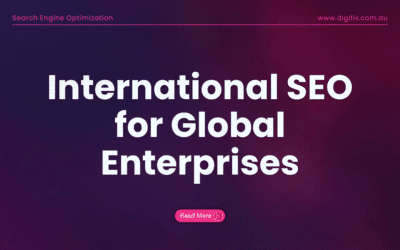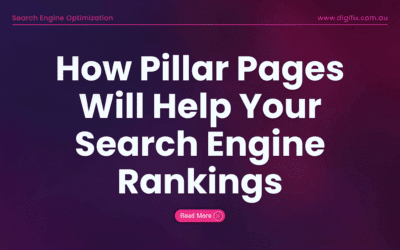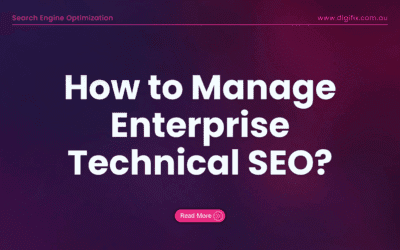Do you know the risks and challenges of moving your enterprise website? A bad migration plan can hurt your search engine rankings and traffic. When thinking about a migration, it’s key to grasp the complexities.
Good website migration services can greatly improve your outcome. Focus on redirects for busy pages, handle URL parameters well, and keep an eye on search traffic. Working with a top SEO agency like DigiFix in Melbourne can help a lot.
Key Takeaways
- Understand the complexities of enterprise website migration
- Prioritize redirects for high-traffic and high-value pages
- Manage URL parameters effectively
- Monitor organic search traffic and keyword rankings
- Partner with a reliable SEO agency for a smooth transition
What is Enterprise Website Migration?
In Australia, moving a big website is a big job that needs careful planning. It’s key to know how to make the move smooth.
Defining Enterprise-Level Website Migrations
Big website moves involve moving a big, complex site with many parts. These are for big companies with lots of online stuff. They need to know their site well and the risks.
Key Differences from Standard Website Migrations
Big website moves are bigger and more complex than usual. They need a detailed plan, involving many teams and tech. Check out our SEO checklist for website migration for more info.
Why Australian Businesses Undertake Complex Migrations
Australian companies move their sites to get better online, improve user experience, and keep up with the market. Using enterprise migration solutions helps them move smoothly, reduce downtime, and grow online.
Preparing for Your Enterprise Website Migration
A successful website migration begins with careful planning. At DigiFix, we focus on transparency and accountability. We make sure every step is clear and easy to follow. To ensure a smooth migration, consider several key factors.
Conducting a Comprehensive Website Audit
Start by auditing your current website. This means checking how well it works, finding areas to improve, and figuring out what needs to be done. It helps you spot problems and plan how to fix them.
Documenting Current Site Architecture and Assets
It’s important to document your website’s structure and content. This includes mapping your site, listing all content, and noting any technical needs. For more help, check out our website redesign tips.
Identifying Technical Debt and Legacy Issues
Spotting technical problems and old issues is key to a smooth migration. Look at your website’s tech, find outdated parts, and plan to update or replace them.
Australian Compliance Considerations
Remember to follow Australian laws during your migration. This means keeping up with privacy and accessibility rules. It helps keep your site safe and legal.
By taking these steps and working with website transition experts, you can migrate your website successfully. It will meet your business goals and improve your online image.
Setting Strategic Migration Objectives
Setting strategic migration objectives is key to a professional website migration. You must align your migration goals with your business objectives for success.
Aligning Migration with Business Goals
Your website migration should support your business strategy. Understand your current business goals and how your new website will help achieve them. Think about improving user experience, enhancing security, or boosting conversion rates.
Establishing Technical Requirements
Technical requirements are vital for a secure website migration. You must identify your new website’s technical specs. This includes the content management system, hosting needs, and integrations with third-party services.
Creating Measurable Success Metrics
To gauge your migration’s success, set clear metrics. This could be website traffic, engagement, or conversion rates. By tracking these, you can see if your migration is working.
ROI Considerations for Australian Enterprises
Australian enterprises should think about the return on investment (ROI) for website migrations. Evaluate the costs against expected benefits like more revenue or better efficiency.
Our SEO strategies are custom-made for you, ensuring a migration that boosts your business.
- Align migration goals with business objectives
- Establish clear technical requirements
- Create measurable success metrics
- Consider ROI for Australian enterprises
Assembling Your Migration Team
To make the transition smooth, you need a good migration team. A successful website move needs people with the right skills.
Essential Roles and Responsibilities
Your team should have different skills. You’ll need a project manager, SEO expert, content strategist, and web developers. Each one is crucial for a smooth move.
Internal vs External Resource Allocation
Choosing between internal staff and external experts depends on your needs. Working with migration specialists can bring in new skills.
Partnering with Australian Migration Specialists
Local experts in Australia know the market well. DigiFix is a great example for Australian businesses.
How DigiFix Supports Enterprise Migrations in Australia
DigiFix offers full migration services, including strategic planning, technical execution, and SEO optimization. They help you move smoothly and boost your online presence. Their team will help you set and meet your goals.
Working with DigiFix has many benefits:
- They handle complex migrations well.
- They offer personalized service for your needs.
- They have a proven track record of success.
With the right team and migration specialists, your move will be a success. Partner with DigiFix and see your online presence soar.
Developing a Robust Enterprise Website Migration Strategy
Enterprise website migration needs careful planning and a solid strategy for a smooth move. A good migration plan reduces risks and keeps your website working for your business goals.
Creating a Detailed Migration Roadmap
First, make a detailed migration roadmap. It should outline every step, from planning to launch. A detailed plan helps spot problems early and keeps everyone on the same page. For example, using expert AEM to WordPress migration services can make the transition easier.
Risk Assessment and Contingency Planning
Assessing risks and planning for them is key. Look out for issues like data loss, downtime, or SEO problems. Having plans ready helps you deal with any problems quickly.
Establishing Communication Protocols
Good communication is essential during a website migration. Make sure everyone knows what’s happening and can share their thoughts. This means regular updates and clear ways to give feedback.
Setting Realistic Timelines for Complex Migrations
Setting realistic timelines is important for a successful migration. Understand the complexity, resources, and possible challenges. Setting reachable goals helps manage expectations and makes the process smoother.
By focusing on these areas, you can create a strong migration strategy. This ensures a smooth transition and supports your business goals. Let us help you make the most of your website with SEO solutions that work.
Critical SEO Considerations During Enterprise Website Migration
A successful website migration needs good SEO strategies. It’s key to keep your online presence and rankings when moving your site. Your team of SEO experts is crucial in making this process smooth and professional.
Preserving SEO Equity and Rankings
Keeping your SEO ranking is a big concern during a website migration. You need to plan and execute carefully to keep your current rankings. Preserving SEO equity means understanding your site’s current status and how changes might affect your visibility.
Comprehensive URL Mapping and Redirection Strategy
A good URL mapping and redirection plan is essential. It ensures links work after the move. Effective URL mapping helps keep your site’s SEO value.
Content Inventory and Optimisation
Reviewing your content is key to finding ways to improve it. This step helps you see what’s working and what’s not. Content optimisation can boost your site’s visibility and user interest.
Benchmarking Current Performance Metrics
It’s important to check your site’s performance before moving it. Look at things like organic traffic and search rankings. Benchmarking helps you see how well the migration goes and where you can get better.
Local SEO Factors for Australian Businesses
For Aussie businesses, local SEO is very important. It means making your site better for location-based searches. Local SEO helps you reach people in specific areas.
By focusing on these SEO points, you can make your website migration a success. Our team of SEO experts offers top-notch services to meet your needs.
Executing Your Enterprise Website Migration
To ensure a smooth transition, having a solid plan for your website migration is key. At DigiFix, we’re all about being open and responsible. We’ll guide you through every step of the migration.
Development Environment Setup
Setting up a development environment is a crucial step. It means creating a copy of your website on a new platform or server. This lets you test everything without affecting the live site. A good development environment makes sure all parts work well before the big move.
Content Migration Methodologies
Content migration is a detailed task that needs careful planning. You must choose whether to move all content at once or in parts. A good plan looks at your content’s type, size, and complexity, and the new platform’s abilities. For tips on getting ready for your website launch, check out our website launch checklist.
Database Transfer Strategies
Transferring databases is a precise task to avoid losing or damaging data. A good strategy checks your current database’s structure and integrity. It maps out the transfer and checks the data after it’s moved. Keeping data safe is key for your business to keep running smoothly.
Testing Protocols and Quality Assurance
Testing your new website thoroughly is essential. This includes checking how it works, its performance, and security. Good testing and quality checks find and fix problems before they affect your users.
Launch Day Procedures and Checklists
Launch day is a big moment in your website migration. A detailed checklist ensures everything goes right and problems are avoided. It covers final checks on content, functionality, and performance, and has a plan for unexpected issues.
By following these steps and using enterprise migration solutions, you can have a secure website migration. This will meet your business goals and improve your online presence.
Post-Migration Monitoring and Optimisation
Ensuring your website migration is a success depends on careful monitoring and optimisation. Website transition experts stress the need to watch your site’s performance closely. This is to keep the user experience smooth and your search engine rankings high.
Tracking Technical Performance Metrics
It’s vital to track important technical metrics after migration. These include page load times, server response times, and error rates. Tools like Google Analytics and server logs offer insights into your site’s performance.
For tips on boosting your website’s performance, check out https://digifix.com.au/from-good-to-great-enhancing-website-performance/.
Monitoring SEO Impact and Rankings
Keeping an eye on your SEO after migration is key to your search rankings. Watch your keyword rankings, organic traffic, and any technical SEO issues. Our SEO strategies are custom-made to fit your needs, keeping your site competitive.
Addressing User Experience Issues
User experience is crucial for your website’s success. Monitor user feedback and track bounce rates and session duration. Make changes to enhance the user experience.
Implementing Iterative Improvements
Optimisation after migration is an ongoing task. Regularly check your website’s performance data for areas to improve. Using analytics to validate migration success helps you understand your site’s performance and where to make changes.
Using Analytics to Validate Migration Success
Analytics tools give you vital insights into your website’s performance post-migration. By looking at traffic, engagement, and conversion rates, you can see if your migration was successful. You’ll also find chances to make your site even better.
Overcoming Common Enterprise Website Migration Challenges
Australian businesses face unique challenges when migrating their websites. A seamless website migration needs careful planning and execution. This helps avoid common pitfalls.
Preventing and Recovering from Traffic Drops
One big challenge is stopping traffic drops during migration. A good URL mapping and redirection strategy can help. For more tips, check out this presentation on SlideShare.
Data Integrity and Loss Prevention
Keeping data safe and sound is key during an enterprise website migration. This means doing detailed audits and checks. It helps prevent data loss or corruption.
Minimising User Experience Disruptions
It’s important to keep the user experience smooth. This means doing lots of testing and quality checks before going live. It helps keep customers happy and engaged.
Managing Internal Stakeholder Expectations
It’s also crucial to manage what internal stakeholders expect. Clear communication and setting realistic goals can help. It keeps everyone on the same page with the project’s progress.
Case Study: Successful Australian Enterprise Migration
A leading Australian retail brand successfully migrated to a new platform. They saw a 30% increase in online sales. With help from experts like DigiFix, they made a smooth transition. You can grow your online presence with expert migration services too.
Conclusion: Maximising Long-Term Value from Your Website Migration
Planning and executing your website migration carefully can bring big benefits. You could save up to 66% on costs and 60% to 70% on time. It’s key to work with experienced migration specialists to get these benefits.
They will help you create a strong migration plan. This ensures a smooth move and reduces any problems. Good migration services also make your business more agile and secure.
Think about using cloud services to get even more from your migration. AWS has shown how moving to the cloud can save a lot of money. Check out their report on maximising economic advantages for more details. With the right team and plan, your website can reach its full potential and help your business thrive.
FAQ
What is the importance of conducting a comprehensive website audit before enterprise website migration?
A website audit is key before migrating. It finds technical problems and areas to improve. This makes the move smoother and better after it’s done.
How do I ensure a seamless website migration with minimal disruptions to user experience?
To migrate smoothly, create a detailed plan. This includes a roadmap, risk check, and backup plans. Also, talk clearly with everyone and set realistic times.
What are the key SEO considerations during enterprise website migration?
SEO is important during migration. Keep your site’s ranking and map URLs well. Check your content and track your site’s performance to avoid ranking drops.
How can I measure the success of my enterprise website migration?
To see if your migration worked, watch your site’s tech and SEO. Fix any user problems and keep improving. Use data to show your migration was a success.
What are the benefits of partnering with Australian migration specialists for enterprise website migration?
Working with experts like DigiFix helps a lot. They ensure a smooth move and keep your site running well. They also use local SEO knowledge to help.
How can I prevent and recover from traffic drops during enterprise website migration?
To avoid and fix traffic drops, use a good URL plan. Keep an eye on SEO and fix tech issues fast. Talk well with everyone involved.
What is the role of enterprise migration solutions in ensuring a successful website migration?
Migration solutions are crucial for a good move. They offer a clear plan and help fix problems. This reduces risks and makes the most of the migration.





0 Comments